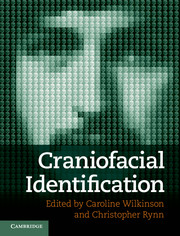Book contents
- Frontmatter
- Contents
- Contributors
- Part I Identification of the Living
- Chapter 1 Familiar face recognition
- Chapter 2 Unfamiliar face recognition
- Chapter 3 EFIT-V
- Chapter 4 Facial recall and computer composites
- Chapter 5 Facial ageing
- Chapter 6 Age progression and regression
- Chapter 7 Computer-assisted age progression
- Chapter 8 Facial recognition from identification parades
- Chapter 9 Virtual human identification line-ups
- Chapter 10 Computer-generated face models
- Chapter 11 Recognising and learning faces in motion
- Chapter 12 Facial image comparison
- Chapter 13 Three-dimensional facial imaging
- Part II Identification of the Dead
- Index
- Plate Section
- References
Chapter 2 - Unfamiliar face recognition
Published online by Cambridge University Press: 05 May 2012
- Frontmatter
- Contents
- Contributors
- Part I Identification of the Living
- Chapter 1 Familiar face recognition
- Chapter 2 Unfamiliar face recognition
- Chapter 3 EFIT-V
- Chapter 4 Facial recall and computer composites
- Chapter 5 Facial ageing
- Chapter 6 Age progression and regression
- Chapter 7 Computer-assisted age progression
- Chapter 8 Facial recognition from identification parades
- Chapter 9 Virtual human identification line-ups
- Chapter 10 Computer-generated face models
- Chapter 11 Recognising and learning faces in motion
- Chapter 12 Facial image comparison
- Chapter 13 Three-dimensional facial imaging
- Part II Identification of the Dead
- Index
- Plate Section
- References
Summary
Introduction
‘Unfamiliar face recognition’ here means the task of recognising someone previously unfamiliar, usually seen only once before. The classic test methodology is to show a sequence of face images and later ask which of a larger set were shown before, but this chapter will also consider face matching, where two or more faces are presented simultaneously. This is one of the more common practical applications, for identity verification. Every time a photo-ID is presented, such as a passport, someone has to match the photograph to the person in front of them. The specific issue of identification parades, where an unfamiliar person has been seen and identification is later attempted from a line-up, is addressed in Chapter 9.
Mostly, face recognition appears effortless, which it usually is, for people that we know well. Where individuals claim to be bad at face recognition, they usually mean that they fail to recognise someone seen perhaps only once before, which is embarrassing, especially if they have recognised you. There is in fact wide variation in ability, from those unable to recognise even highly familiar people, to a few who can recognise someone seen only once, some years earlier (Russell et al., 2009).
- Type
- Chapter
- Information
- Craniofacial Identification , pp. 11 - 23Publisher: Cambridge University PressPrint publication year: 2012
References
- 1
- Cited by



